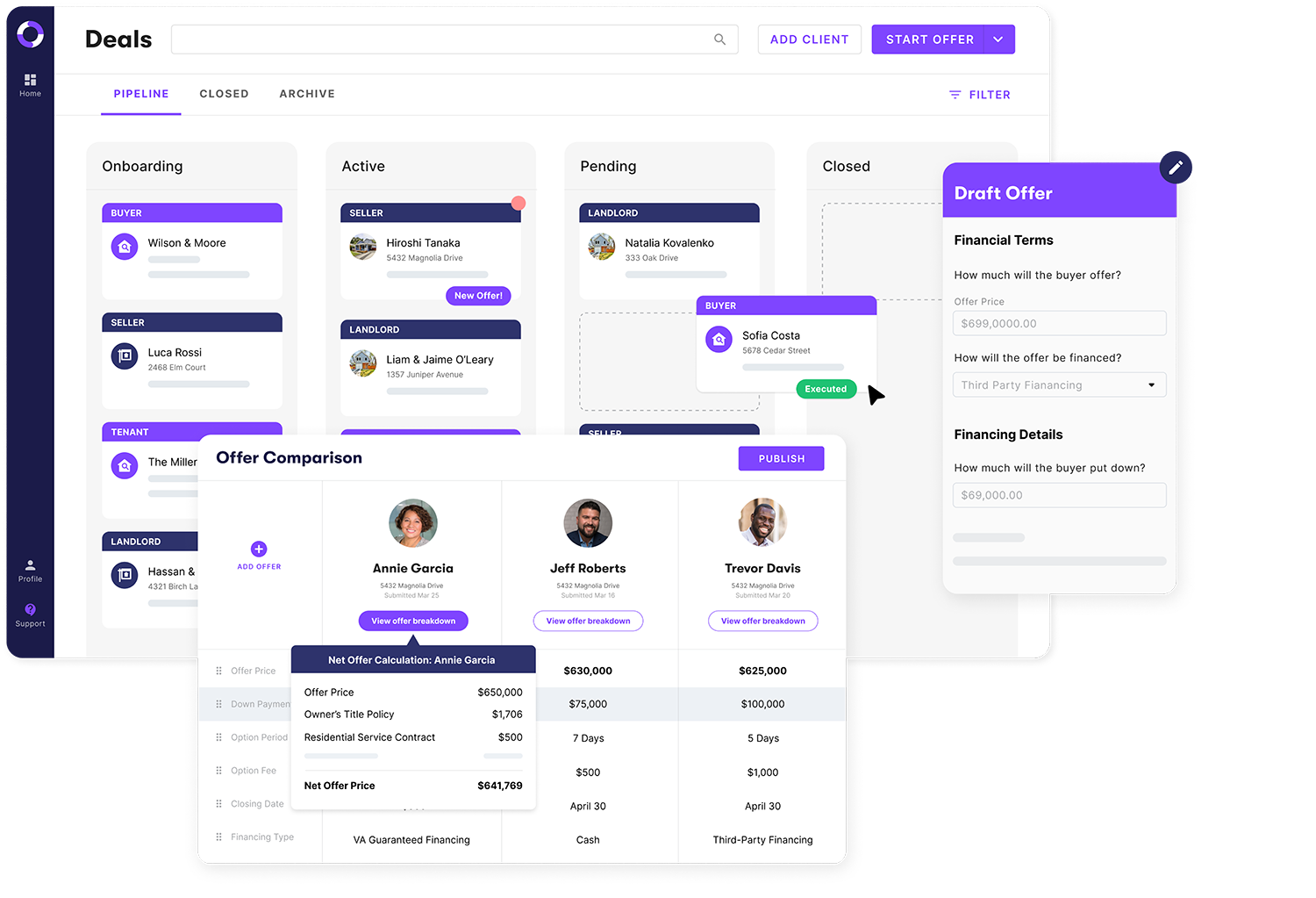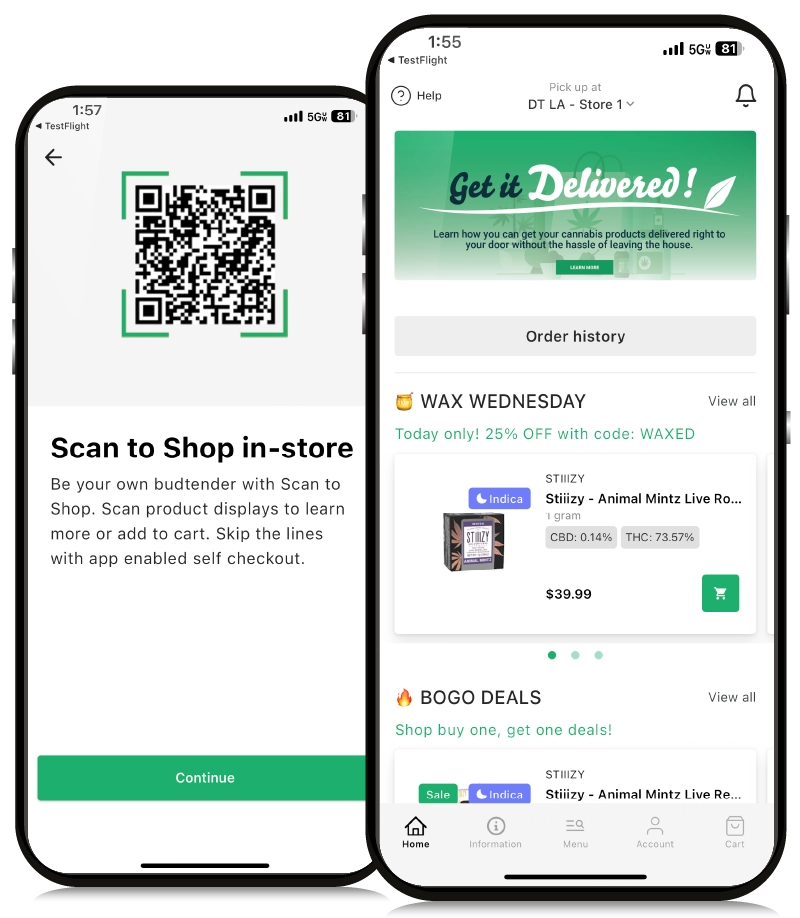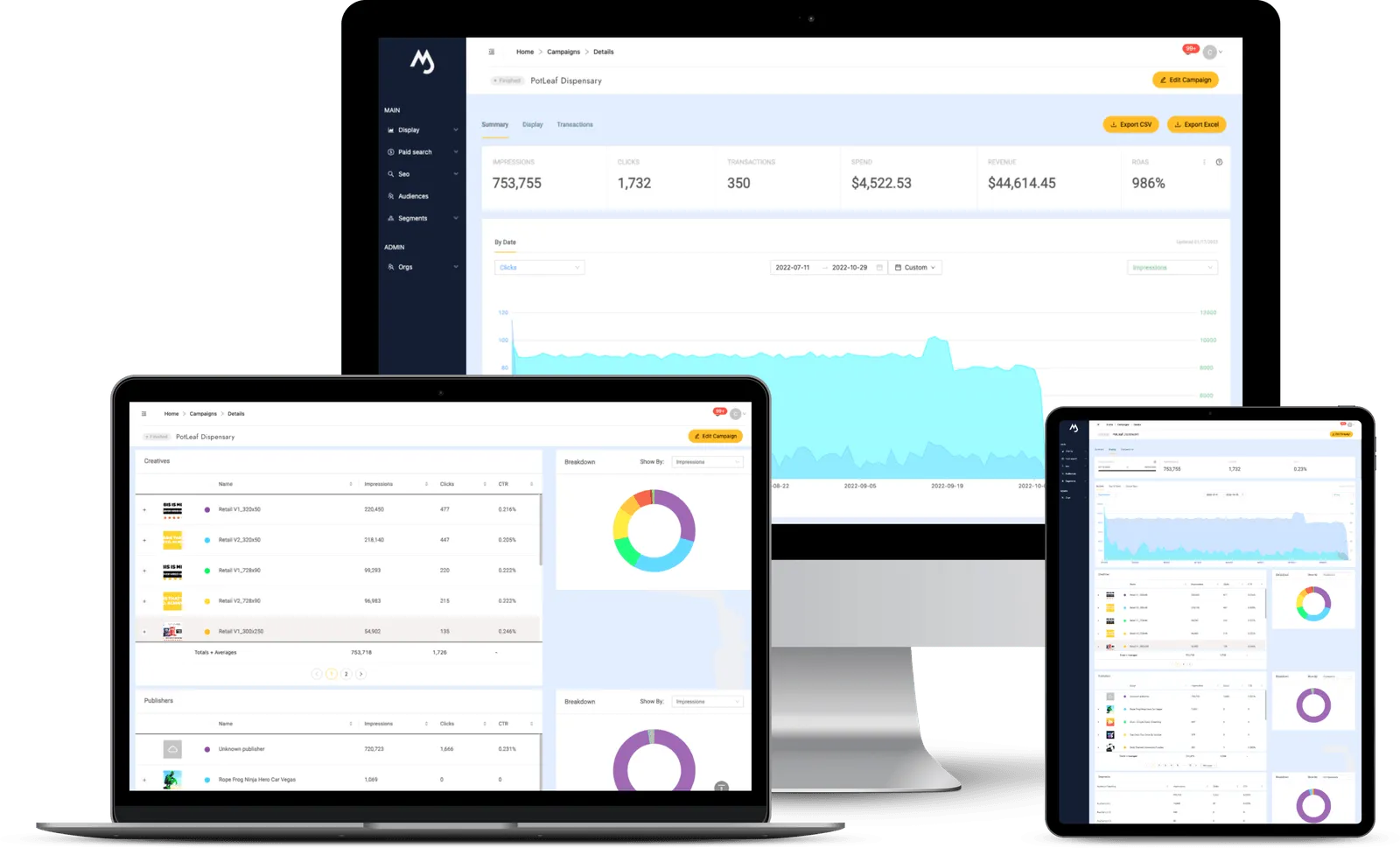The Next Wave in Cannabis Retail: Smart Stores

The American retail sector is experiencing a structural shift and redefining how shopper packaged items manufacturers and retailers strategy promoting and advertising and marketing. Superior applied sciences like synthetic intelligence (AI) and the web of issues are fueling the rise of “good shops,” bridging the hole between on-line and in-store buying. From AI-powered buying assistants and scan-to-shop know-how to holographic shows, kiosks, and related TV (CTV), firms are constructing retail media networks that create new, trackable promoting alternatives. These improvements present manufacturers entry to extra of a retailer’s wealthy first-party information, enabling exact viewers concentrating on and real-time measurement of advert efficiency all through the client journey.
For dispensaries, this shift represents a solution to improve the buying expertise and affords a profitable new income stream by offering manufacturers an omnichannel promoting platform for connecting with shoppers.
Dispensaries might profit from the rise of retail media networks greater than conventional shops. With mainstream promoting channels like Google, Meta, and linear TV nonetheless out of attain as a result of federal restrictions, hashish retail manufacturers face vital hurdles in conventional advertising and marketing. Furthermore, state-by-state legalization limits firms to working solely inside their native markets, diminishing the necessity for pricey nationwide campaigns. This makes retail media networks a really perfect resolution by offering hyper-localized promoting choices that capably handle the business’s regulatory and geographic challenges.
Reducing-edge instruments retailers can leverage to boost the buying expertise whereas gathering and using invaluable first-party information are simply starting to look. AI-driven capabilities enable for dynamic, customized promotions that interact shoppers as they store, fostering stronger connections between customers and adverts. Manufacturers now can combine their promoting throughout retailers’ ecosystems—via e-commerce platforms, cell apps, and bodily shops—whereas benefiting from digital monitoring’s clear, real-time efficiency metrics.
AI-powered buying
Companies generally use AI within the type of customer support chatbots or to offer customized suggestions and enhance e-commerce searches, however AI is making its approach into the retail setting. Google Purchasing made the transfer with Google Lens, an app that permits you to snap an image of a product and immediately uncover the place to purchase it, evaluate costs, and examine stock—all in actual time.
AI-assisted buying is especially helpful within the hashish business due to the novelty of consuming the plant in an edible, beverage, or vape format and the unlucky relative shortage of related science. Most individuals grapple with understanding cannabinoids and their advantages, the variations between manufacturing processes, and the dizzying variety of strains within the market.
Whereas journaling and product-matching apps have struggled to achieve traction as standalone platforms, some builders are discovering success now by integrating their software program inside dispensary ecosystems. This new technique permits apps to leverage dispensary infrastructure and create a extra sturdy shopper expertise.
One standout instance is Jointly, an app that has been refining its platform since 2018 by partnering with dispensaries. Collectively allows customers to trace their hashish consumption, offering wealthy information insights into what merchandise and mixtures work greatest for numerous targets. “We collect shopper insights on what’s efficient for customers and share that data with others to assist information their product choice,” mentioned Chief Govt Officer David Kooi. By harnessing the info, Collectively affords dispensaries a collection of AI-powered instruments, together with a digital budtender for web sites and kiosks and a budtender gross sales assistant, benefiting each the buyer expertise and dispensary operations.

Collectively’s digital budtender lives on the dispensary’s web site and acts like a web based concierge, serving to information folks via the menu or reply questions like “What are your hours? What’s the distinction between CBN and CBG? Do you’ve gotten a parking zone?” Accessible via each web sites and in-store kiosks, the digital budtender might help improve basket sizes by practically 25 %, in line with Kooi.
In the meantime, Collectively’s budtender gross sales assistant helps in-store employees by integrating with point-of-sale techniques. The software program affords real-time entry to product stock and gross sales information, serving to budtenders present extra exact suggestions. “There are tons of of SKUs in a retailer, and it’s unrealistic for employees to be conversant in all of them,” Kooi defined. “It’s a instrument to assist budtenders match folks extra exactly with merchandise of their retailer. Some folks simply use it as a coaching instrument; a spot to ask questions and get solutions. Others are beginning to use the phrases ‘skilled improvement’ round it, which I’m fairly enthusiastic about.”
Collectively employs machine studying know-how, that means the extra the app is used, the extra educated it turns into. “The purpose is to gather as a lot helpful information as potential and put it to make use of for shoppers,” mentioned Kooi, who sees a bigger convergence of personalization taking place within the hashish business via advertising and marketing and e-commerce instruments. “Hashish is a private expertise, however the buying expertise is usually a little impersonal proper now. The extra customized we will make it for folk, the higher expertise they are going to have.”
A twist on the Collectively app is HashDash, which focuses on matching shoppers with strains. Not like Collectively, which emphasizes product suggestions throughout a broad vary of standards, HashDash zeroes in on traits, utilizing a classy algorithm to direct customers to close by dispensaries carrying particular strains or merchandise with related cannabinoid and terpene profiles. HashDash additionally companions with dispensaries and integrates into their point-of-sale techniques to offer the identical product pairing capabilities.
With a database of greater than 5,200 strains and 630,000 information factors, HashDash leverages AI and machine studying to refine its matching capabilities based mostly on consumer interactions. The app additionally permits customers to share their experiences with completely different strains. As an example, Suzy from New York would possibly report success in assuaging migraines with myrcene-rich OG Kush, guiding others with related signs towards doubtlessly efficient choices.
Scott Lynch, CEO of HashDash, defined, “Our purpose is to assist shoppers perceive hashish at its most basic stage: strains, terpenes, and cannabinoids. These are the constructing blocks for understanding hashish’s results, far past the outdated sativa-versus-indica categorization.” By educating customers about these complexities, HashDash goals to deepen shoppers’ data and assist them make extra knowledgeable selections.
Along with its consumer-facing options, HashDash affords manufacturers a invaluable promoting platform. Not like broader platforms like Weedmaps or Leafly, which promote advert impressions based mostly on value per thousand, HashDash makes use of its in-depth shopper desire information to ship hyper-targeted adverts. “The [return on investment] for manufacturers is considerably increased, as a result of we tailor adverts to particular person shoppers’ particular wants and behaviors,” mentioned Lynch. “This stage of precision permits manufacturers to attach extra successfully with their target market, driving higher engagement and gross sales.”
Holographic shows: the way forward for promoting
Holographic shows are making waves in conventional retail as a cutting-edge solution to captivate shoppers and revolutionize in-store promoting. By providing a visually spectacular expertise, manufacturers are betting the futuristic shows will likely be unattainable for customers to stroll by and ignore.
Shawn Landgraf, CEO of holographic show firm Holovisn, is piloting the know-how in hashish with a significant multistate operator. This system exams whether or not holographic promoting can drive gross sales and makes use of efficiency information to draw manufacturers to undertake the know-how. “Our purpose is to show that holographic shows are extra than simply eye-catching,” he mentioned. “They could be a highly effective gross sales instrument.”
In line with Landgraf, the most important a part of his enterprise in conventional sectors is creating “holographic people” who can work together with shoppers. “Utilizing AI capabilities and holographic know-how, we put Barbie right into a field for our consumer Disney,” he mentioned. “We needed folks to have the ability to stroll up, have a dialog, see her dance and even drink a [beverage from] Starbucks. These are a number of the future capabilities of holographic know-how.” Holovisn additionally created a real-life model of Usher for the performer’s current world tour so followers may interact with him. Snoop Dogg, are you listening?
One widespread concern with adopting holographic shows is the perceived excessive value. Nonetheless, Landgraf emphasised Holovisn affords versatile pricing fashions. “We offer two choices: Manufacturers should purchase the holographic tools outright, or we will deploy the know-how without charge to the dispensary. Within the latter case, we collaborate with the dispensary to onboard advertisers, sharing income based mostly on the model’s preliminary funding,” he mentioned. This flexibility lowers the barrier to entry, making it simpler for dispensaries and types to experiment with holographic promoting. By turning retail areas into interactive, high-tech environments, holographic shows may provide a major edge in fascinating clients.
Holographic know-how has the potential to rework hashish retail by delivering a novel and memorable buying expertise. As extra dispensaries discover the medium, they’ll differentiate themselves and unlock new income streams via model partnerships. If early pilots like Holovisn’s show profitable, we might quickly see holographic shows as a typical characteristic in dispensaries, altering the way in which merchandise are marketed and offered.
Scan-and-go is one step forward
The hashish business is taking cues from mainstream retail improvements, with scan-and-shop know-how main the cost. Instacart lately debuted a scan-and-pay app that lets grocery customers skip the checkout line. BLAZE is pioneering related know-how for hashish. Scott Roehrick, vice chairman of e-commerce, defined the corporate’s system allows clients to stroll via a dispensary, scan merchandise to be taught extra, add objects to their cart, and full the checkout course of totally on their telephones.
Roehrick admits the know-how, which BLAZE calls Scan to Store, is barely forward of its time for dispensaries since most merchandise are locked inside glass show instances or digitally displayed. Early adopters like Airfield Provide Co. in San Jose, California, are leveraging it nonetheless. Airfield CEO Mark Matulich mentioned, “Scan to Store works nicely. I want we had extra clients adopting it.” With its open-shelf format, Airfield permits clients to browse, scan QR codes for detailed product data, and store at their very own tempo.

Scan to Store is making waves at massive business occasions, in line with Roehrick. BLAZE carried out the system at main expos like The Emerald Cup, Hall of Flowers, and Flower Expo, streamlining the customarily cumbersome buying course of at vendor cubicles. Beforehand, attendees would obtain tickets to redeem merchandise at a separate pickup location, resulting in lengthy strains and the danger of sold-out objects. With Scan to Store, attendees can scan a product’s QR code, add it to their digital cart at any level through the occasion, and take a look at once they’re prepared with out worrying the merchandise gained’t be out there.
The know-how is poised to be a game-changer as extra public occasions, akin to concert events and state gala’s, start to permit on-site hashish gross sales. Occasion producers can use Scan to Store to trace stock and streamline transactions throughout a number of distributors, making a extra environment friendly and satisfying buyer expertise.
BLAZE is also constructing dispensary-branded cell apps (assume Starbucks) to seize gross sales and incentivize loyal clients who need unique offers. As an example, dispensaries can provide app-exclusive offers—akin to a particular promotion each Friday—whereas utilizing push notifications to interact immediately with their viewers. It’s all about assembly clients the place they’re and maintaining them in your ecosystem. Roehrick identified, “Selecting the best mixture of in-store know-how is dependent upon your retail footprint and enterprise targets. It’s about understanding the way you need clients to maneuver via the worth chain and incentivizing them successfully.”
As hashish retail continues to evolve, applied sciences like Scan to Store and branded cell apps will play an more and more essential function. By making buying extra seamless and customized, these instruments not solely improve the client expertise but in addition increase dispensaries’ gross sales and effectivity. As soon as mainstream retail totally adopts scan-and-go buying, shoppers will come to count on it in dispensaries.
Offsite kiosk partnerships
Offsite kiosk alternatives are rising for retailers and types, enabling product supply via non-cannabis companies in a compliant and handy method. Branded kiosks provide dispensaries expanded title recognition and the possibility to faucet into new income streams via product gross sales and focused model ads.
One of the thrilling purposes of the know-how is inside the rising subject of hashish tourism. As extra vacationers search plant-friendly lodging, resorts and trip leases will begin to cater to this demographic. Platforms like Bud and Breakfast and HiBnB already listing marijuana-friendly properties worldwide. By putting in kiosks that enable orders on website with supply or pick-up at a close-by dispensary, such institutions can present friends with a straightforward solution to discover and buy merchandise. Properties sustaining a smoke-free ambiance can curate kiosk menus that includes smoke-free merchandise akin to topicals, edibles, and drinks. This is able to enable them to accommodate plant-aware shoppers with out compromising the consolation of non-smoking friends.
Past resorts, points of interest just like the cultural museum THC NYC are leveraging kiosks to raise the theme and customer expertise. The supply kiosk permits patrons to put an order, benefit from the displays, and obtain a notification when their objects are prepared for pick-up. A kiosk additionally may be discovered within the museum’s fifth-floor lounge and occasion area, providing friends the comfort of on-site supply throughout non-public occasions or after a protracted day of exploring the displays.
CTV with shoppable adverts
A ShareThrough survey discovered 60 % of respondents had bought merchandise on their cellphone, laptop, or pill after seeing an advert on TV, and 58 % mentioned they might use their distant to purchase a product or entry a coupon if supplied.
With its interactive options, CTV promoting will increase viewer engagement via QR code buying options. Hashish-focused channels like Citizen Inexperienced TV are capitalizing on this pattern, providing real-time interactivity via QR codes that hyperlink viewers to unique offers, certificates of research for lab-tested merchandise, or model storytelling pages. Plus, with CTV’s video-on-demand functionality, viewers can pause to discover manufacturers they’re concerned about, making the know-how a robust brand-building instrument.
Citizen Green TV even permits buying, the place viewers can hover over merchandise with their distant so as to add objects to a buying cart for speedy buy, which they’ll choose up on the nearest dispensary. Manufacturers can also leverage on-demand printing to promote branded merchandise, including further worth to their CTV adverts. Entrepreneurs view QR codes as a “golden ticket” for monitoring conversions and measuring success, giving manufacturers a direct path from publicity to motion.
Cryptocurrency app Coinbase is an ideal instance of how efficient QR codes may be. Coinbase featured a QR code with a name to motion and a particular provide in a one-minute spot throughout Tremendous Bowl LVI. In line with information stories, so many soccer followers scanned the code that the corporate’s web site crashed on account of the elevated site visitors.
Walmart launched its first shoppable CTV adverts that includes QR codes through the 2024 Thanksgiving night time NFL sport, pointing to the rising bridge between digital and retail promoting. NBCUniversal elevated its variety of advertisers by 40 % by increasing its programmatic shopping for and providing performance-based campaigns.
Actor Ryan Reynolds is betting on CTV promoting as the subsequent frontier for entrepreneurs. His firm, Maximum Effort Marketing, lately was acquired by MNTN, a CTV promoting know-how agency. Reynolds serves as chief inventive officer and is creating industrial content material concentrating on small companies that sometimes draw back from TV promoting due to the price. Reynolds claims 90 % of Most Effort Advertising and marketing’s shoppers are first-time TV advertisers.
Traditionally, TV advertisers needed to depend on belief that their adverts would attain the supposed viewers, with restricted choices for monitoring effectiveness. Jake Litke, CEO of MediaJel, an adtech platform specializing within the hashish business, has developed an attribution platform that provides entrepreneurs entry to invaluable CTV promoting information. “The principle pillar of our performance is the power for advertisers to see how their adverts affect gross sales via exact monitoring information,” he mentioned.
Litke believes the time is good for hashish manufacturers to embrace CTV promoting. “Not solely is it a possibility we’re prepared for, nevertheless it’s additionally an uncrowded area for the hashish business proper now. Your competitors will possible be insurance coverage adverts and related content material, not different hashish manufacturers.”

He encourages advertisers to offer CTV a strive, noting, “There’s a false impression that you just want a Tremendous-Bowl-quality advert for CTV, however that’s not vital. Even fundamental adverts work nicely on this platform.”
As for funds, Litke suggested, “In the event you’re concentrating on a selected neighborhood, you don’t want an enormous funds. However, sometimes, you must plan for tens of 1000’s of {dollars} to see impactful outcomes.”
North American president of Citizen Inexperienced TV, Steve Peterson, agreed CTV is a game-changer. “Integrating adverts into streaming video content material and delivering them to a focused, scalable market is the subsequent evolution in hashish promoting,” he mentioned. “Streaming TV affords hashish manufacturers entry to a large demographic, making it an untapped platform for standing out in an more and more aggressive market.”
The way forward for retail media
Because the hashish business embraces cutting-edge retail applied sciences, creating a completely related retail media community is the subsequent frontier. Investing in sturdy attribution platforms will likely be essential for dispensaries to maximise the potential of those improvements. The techniques can present granular insights into the client journey, from preliminary engagement with a holographic show or digital budtender to the ultimate buy, whether or not in-store or via scan-to-shop know-how.
AI-driven analytics will enable accuracy in measuring return on advert spending, shifting past obscure “gross sales bumps” to pinpoint which campaigns, touchpoints, or applied sciences actually drive income. In a market the place compliance limits conventional promoting, constructing and optimizing these omnichannel ecosystems is the increase retail companies want.
The hashish retail revolution is underway, and people who seize the second and combine modern know-how and exact attribution will lead the business into its subsequent development section.




